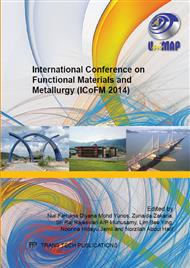p.71
p.76
p.81
p.87
p.91
p.97
p.103
p.109
p.117
The Microstructure and Mechanical Properties of Al/Al2O3 Surface Composite Layer Produced by FSP Green Technique
Abstract:
In this study, alumina powder of two particle sizes, 1.0 and 3.0 μm were dispersed into the surface layer of pure commercial aluminum sheets by Friction Stir Processing technique (FSP) to produce a composite surface layer of Al/Al2O3. The processing parameters such as traverse speed and applied load were kept constant throughout the whole process at 45 mm/min and 10 kN respectively. Samples were subjected to various numbers of FSP passes from 1 to 3. The effect of tool rotation speed, alumina particle size and the number of the FSP passes on material flow were investigated. Mechanical properties evaluation of the surface layer revealed that hardness and strength are a result of the interactions of FSP passes and tool rotational speed. The increments in hardness of the surface layer showed big variation between samples of small alumina particle size and that of larger alumina particle size. Finer particles gave better hardness and strengthening effect than the coarse particles did. Microstructural observations were carried out using optical and scanning electron microscopy (SEM) on samples’ cross sections perpendicular to the tool traverse direction.
Info:
Periodical:
Pages:
91-96
Citation:
Online since:
June 2015
Authors:
Keywords:
Price:
Сopyright:
© 2015 Trans Tech Publications Ltd. All Rights Reserved
Share:
Citation:


